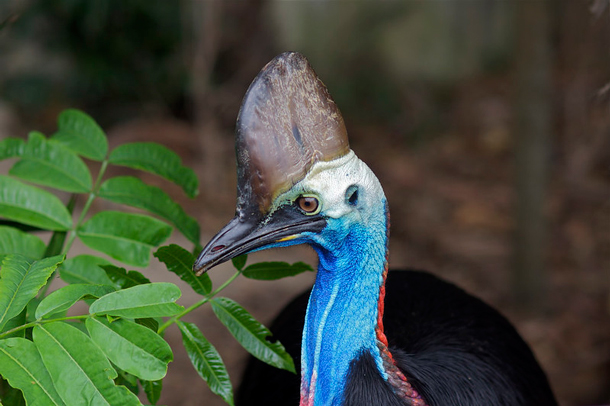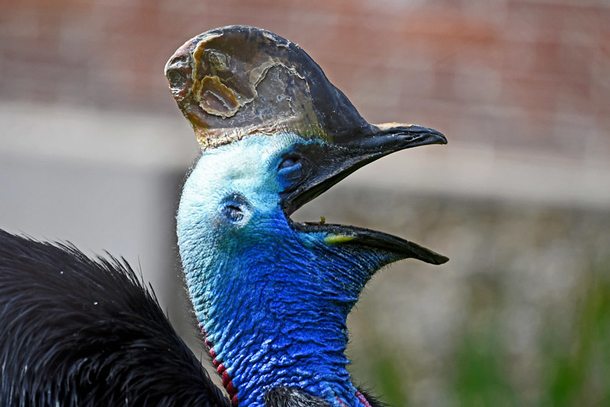BirdNote®: Encounter with a Cassowary
Air Date: Week of January 10, 2020

The Southern Cassowary is easily identified by its blue head, grey casque, and red wattle at the back of its neck. (Photo: CC Kirsty Komuso)
BIRDNOTE®: ENCOUNTER WITH A CASSOWARY: BirdNote's Mary McCann describes an interaction with a Southern Cassowary, a huge, flightless, and almost-prehistoric looking bird. Found in the forests of Northern Australia, it has the lowest-pitched birdcall in the world.
Transcript
CURWOOD: According to a University of Sydney ecologist, the raging wildfires in Australia have claimed as many as a billion animals in the dry bushlands in the southeast of the country. The more tropical northern part of the continent has been spared for now and as BirdNote®’s Mary McCann reports that’s where we find one of the largest, most unusual, birds in the world.
[Cassowary “coughing” calls]
MCCANN: That coughing sound is the call of a Southern Cassowary. It’s a huge, flightless, prehistoric-looking bird, found in the tropical forests of Northeastern Australia, New Guinea and Indonesia.
This bird would look right at home in Jurassic Park. It weighs about 150 pounds and stands nearly six feet tall with a striking bony crest. Its head and long neck are a deep blue... bare and featherless. It looks a lot like an Ostrich, but it’s covered in coarse, black feathers that almost look like fur. Two bright red wattles, like those of a Wild Turkey, dangle from its throat.

The Southern Cassowary is found in the northern forests of Australia. (Photo: CC Brian Henderson)
Cassowaries eat mostly fruit, but they’ll take just about any food that presents itself… plants, frogs, insects and the like. Females are bigger than males, sometimes a lot bigger. Unlike many other birds, males alone incubate the eggs and care for the young up to nine months.
And cassowaries are capable of making remarkable sounds:
[“Roar” of the Dwarf Cassowary]
But how about this call?
[Cassowary subaudible calls]
It’s the lowest-pitched bird call in the world, and it’s barely audible to the human ear.
I’m Mary McCann.
###
Written by Bob Sundstrom
Bird audio provided by The Macaulay Library of Natural Sounds at the Cornell Lab of Ornithology, Ithaca, New York. Foraging sounds of a Southern Cassowary recorded by L. Macaulay. Queensland ambient recorded by E. Brown.
Various calls of Southern and Dwarf Cassowary recorded and provided by Andrew Mack.
Producer: John Kessler
Executive Producer: Sallie Bodie
Editor: Ashley Ahearn
Associate Producer: Ellen Blackstone
Assistant Producer: Mark Bramhill
BirdNote’s theme music composed and played by Nancy Rumbel and John Kessler
© 2019 BirdNote December 2013 / 2019 Narrator: Mary McCann
ID# 120406casso cassowary-01b
https://www.birdnote.org/show/encounter-cassowary
CURWOOD: For photos, strut on over to the Living on Earth website, LOE dot org.
Links
Find out more on the BirdNote website
Learn more about the Southern Cassowary from Birdlife Australia
Living on Earth wants to hear from you!
Living on Earth
62 Calef Highway, Suite 212
Lee, NH 03861
Telephone: 617-287-4121
E-mail: comments@loe.org
Newsletter [Click here]
Donate to Living on Earth!
Living on Earth is an independent media program and relies entirely on contributions from listeners and institutions supporting public service. Please donate now to preserve an independent environmental voice.
NewsletterLiving on Earth offers a weekly delivery of the show's rundown to your mailbox. Sign up for our newsletter today!
 Sailors For The Sea: Be the change you want to sea.
Sailors For The Sea: Be the change you want to sea.
 The Grantham Foundation for the Protection of the Environment: Committed to protecting and improving the health of the global environment.
The Grantham Foundation for the Protection of the Environment: Committed to protecting and improving the health of the global environment.
 Contribute to Living on Earth and receive, as our gift to you, an archival print of one of Mark Seth Lender's extraordinary wildlife photographs. Follow the link to see Mark's current collection of photographs.
Contribute to Living on Earth and receive, as our gift to you, an archival print of one of Mark Seth Lender's extraordinary wildlife photographs. Follow the link to see Mark's current collection of photographs.
 Buy a signed copy of Mark Seth Lender's book Smeagull the Seagull & support Living on Earth
Buy a signed copy of Mark Seth Lender's book Smeagull the Seagull & support Living on Earth

